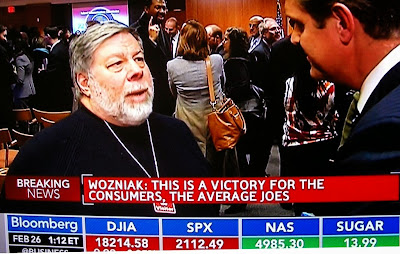PHOTO: Apple co-founder Steve Wozniak, who in the 1970's was a technician at Hewlett-Packard' personal computer division in Cupertino before he designed the first Apple computer for Steve Jobs, is shown telling Bloomberg TV reporter his favorable reaction the net neutrality decision by the FCC on Feb. 26, 2015, which is popularly explained as forbidding internet service provider from intentionally running "slow lanes" for some services and not others in an equal manner for profit. More technically, critics object to the FCC adopting well litigated and established 1930's regulations, originally intended for utilities such as telephone companies and radio broadcasts, which gives the FCC broader power. In my view, the FCC has not done anything wrong, so far, because the real issue with network connections to homes is no different than similar issues with providing public streets, roads and highways to a home because there is a limited amount of public space and deciding how to allocate this space should be a democratic public process instead of a private decision made by capitalists focused only on maximizing shareholder profit. Specifically, it doesn't matter if you get your internet connection from a cable TV wire, a telephone DSL wire, or a yet-to-be-invented wireless service, because in all of these cases there is a limited amount of public right-of-way space, which in practice has limited the number of competitors in most cases to be less than two companies and switching services is very difficult to do. Today's network connections have the same problem that telephones and radio broadcasts presented in the 1930's when multiple companies tried to string telephone wires or broadcast radio in a limited amount of public-right-of-way space. Yes, as the old analog TV channels are shut down and are replaced by digital channels, the FCC will be reallocating the electromagnetic spectrum for new services that may include better 5g phone systems and wireless internet connections, but this public space will always be limited and should be regulated by a public process.
PHOTO: The Apple watch was introduced on the "Spring ahead" clock time change day Mar. 9, 2015 with an ad in the Vogue Magazine, Mar. 2015 issue.
PHOTO: Hewlett-Packard model HP-01 calculator wristwatch advertisement from 1977. See previous posts HP calculator wristwatch 1977 vs. Timex 1994 (11/9/10). Google Android Sony SmartWatch apes HP-01 LED watch from 1977 (7/1/12) and Apple watch apes 1970's HP watch (9/26/14).
When HP introduced a watch in the 1970's they had a reputation for expensive and high-end electronic devices and market research in the 1970's convinced HP to market the HP-01 through jewelers who specialized in watches at the time. Needless to say, this proved to be a losing strategy and HP abandoned the project to develop a less expensive version for the masses. It appears Apple is facing the same situation where they feel like they must first sell their watch as an expensive fashion accessory until they can lower the price down to where the masses will buy it.
Another thing mentioned on Bloomberg about all Apple devices, including the Apple iPad and iPhone, are the low vision accessibility instant access features built-in that are being used by those with impaired vision and low vision blindness.
I am very familiar with the accessibility features provided by Microsoft that were inspired by their collaboration with Stephen Hawking, but I am less familiar with features built-in Apple devices because I have only used Apple products to do competitive analysis during my three decades spent as a competitor to Apple at the Hewlett-Packard Company. Here are some links to Apple and other companies that provide accessibility products:
- LS&S Proudcts for the visually impaired and hard of hearing - sells Odin VI Mobile Phone - Unlocked Version sold by lssproducts.com
- Bloomberg interviewed Ed Summers talking about his use of the Apple Instant Access low vision smartphone features - See Diane Brauner and Ed Summers, "iOS Accessibility, Teaching the Teachers," Future Reflections, (Magazine for Parents and Teachers of Blind Children published by the American Action Fund for Blind Children and Adults in partnership with the National Organization of Parents of Blind Children) VOl. 32, Number 1, Winter 2013 National Federation of the Blind nfb.org
- Diane Brauner, Teacher of the Visually Impaired, Certified Orientation and Mobility Specialist, Ed Summers, Senior Manager, Accessibility and Applied Assistive Technology SAS, "Settings for iPad Accessibility Features for Blind and Low Vision Students iOS 7.1," support.sas.com 2014 accessed Mar. 23, 2015 (PDF 889kB 24 pages)
- Ed Summers compared Apple to the NFB Products and Technology - Blind consumer leaders from throughout the United States take the lead in setting priorities and in promoting the use of new devices which hold promise.
- National Federation of the Blind Reader -- converts the content of printed documents into clear synthetic speech, and is now available as an iOS app - See About K-NFB Reading Technology, Inc. a joint venture between Kurzweil Technologies, headed by CEO Ray Kurzweil
- Michael Hansen, "AppleVis Extra #23: KNFBReader Mobile," AV AppleVis Jul 22, 2014


